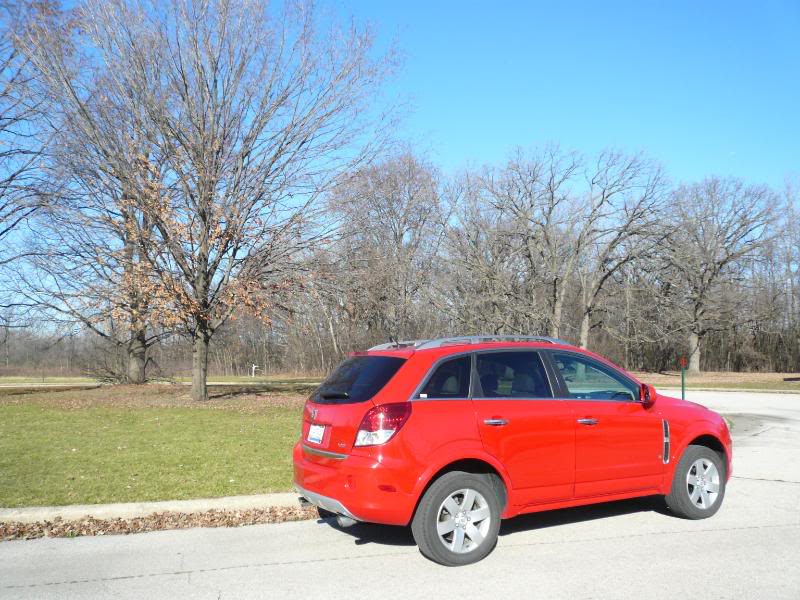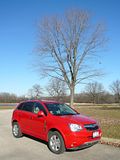

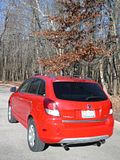
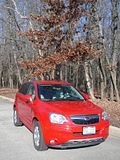
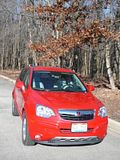
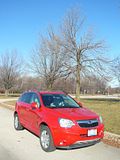
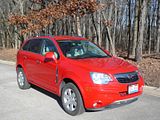
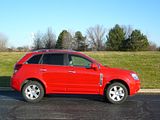
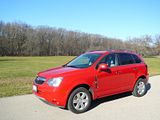
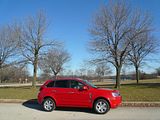
With the memory of the Pontiac Torrent still fresh in my mind, I arrived at Chicago O’Hare airport, to find that one of its GM stablemates, and also a prime competitor, the Saturn Vue, was to be my transport for the next few days. The latest Vue model was launched in the US a couple of years ago, and unlike its predecessor which was a purely US design, this one is a very close relative of the car sold by Vauxhall and Opel as the Antara in European markets, itself sharing much of its underpinnings with the Chevrolet Captiva (in reality, a Daewoo, but we are not allowed to call them that any more). As far as I can discern, this design bears no relation to the Chevrolet Equinox, either in its outgoing or incoming guises. Confused? Wondering why GM needs so many different platforms and models all competing in the same segment of the market? Even GM clearly reckoned this was not sustainable, and as part of their recovery plan, they concluded that after the attempt to sell the Saturn brand to Penske fell through, then Saturn would go the way of Pontiac and is being phased out.

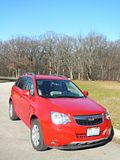
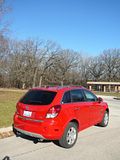
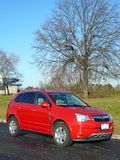
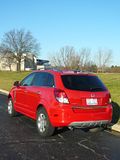
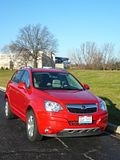
The Antara is a rare sighting in Europe, and I have never been totally convinced by its looks. The test Saturn, I thought, had a certain presence about it. Doubtless this was helped by the vibrant red paint work, a colour that is officially called Chilli Pepper Red. Closer inspection reveals quite a few detailed styling differences from its European cousins. The Saturn grille is the most obvious alteration, along with the presence of the US-style reflectors in the corners of the bumpers. The bumpers are different and lots of detail of trim are also altered for the US market. In the XR trim level of the test car, the bumpers are body coloured, and when I saw a lesser XE model as a comparison point, which had ugly black pained bumpers, I thought this one feature alone does make a significant visual difference.
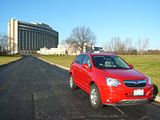
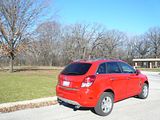
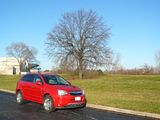
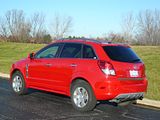
Saturn offer the Vue with a choice of 3 different capacity engines, and until recently, also with optional Hybrid technology. Front wheel drive and four wheel drive options are available for all models. Entry level cars use the same 2.4 litre 4 cylinder engine that is offered in the petrol-powered Antara in Europe, but this is a slow seller in the US, where the larger V6 models are far more popular. The test car had the slightly larger of the two V6s, with 254 bhp available from its 3.6 litre engine, a power plant it shares with the Aura saloon. If I had been asked to guess, I would have rated this motor as more powerful than the older design 3.4 litre engine that featured in my recent Torrent test car, as it certainly felt that little more urgent when flexing your right foot on the accelerator pedal, and now I know that the Pontiac was only developing 185 bhp, my hypothesis was indeed correct. Whilst not making the Vue a fast car, it proved more than up to the job of allowing the Saturn to shoot out into the traffic of the Chicago suburban freeways where a burst of initial acceleration is frequently called for. There is a six speed automatic transmission, which did the job so effectively that it was very hard to tell which gear you were in, or even when it changed from one ratio to another. The only manual control available is to select a low ratio, which is found behind the “D” position on the centre console mounted gearlever.
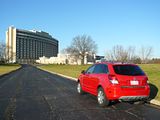
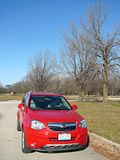
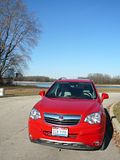
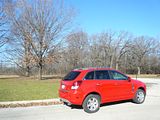
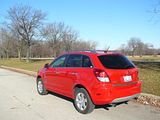
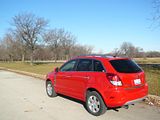
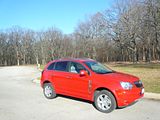
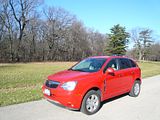
The test car was a front wheel drive model, but if I am being honest, I was only able to tell from the paper work that accompanied the car. The test mileage was conducted on the freeways and surface streets of the Chicago suburbs, which test little more than the ride quality, and noise levels of a car rather more than the handling and steering. There are, however, some tight curves on the ramps that connect the freeways together as you emerge from O’Hare airport and I thought there were no issues or surprises in the way the Vue tackled these bends, at moderate speed. The steering is appropriately weighted and offered a reasonable clue as to what the steered wheels of the Vue were going to do in response to my movement of the leather trimmed wheel. Noise levels were commendably low, a consequence of the gearing, no doubt, though the notorious ribbed concrete surfaces of the freeways generated the same odd sounds as you get in absolutely every car I have ever driven in the area. If you ever do get into real trouble, the Vue sports the OnStar system, with the buttons to initiate a call located right by the interior courtesy lights. Fumbling for these latter in the dark, I nearly ended up contacting the Call Centre by mistake, which would be embarrassing.
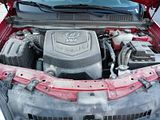
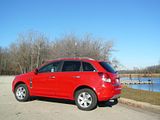

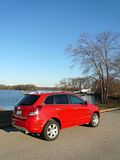
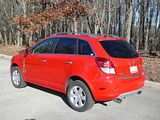
The Vue also shares its main cabin design with the Antara, though, again there are detailed differences, especially around the centre console. Although there is nothing fundamentally wrong with the cabin design or quality, it just did not quite appeal to me. Maybe it was the rather odd texture to the beige leather seats which looked like they had endured a hard time in the 22,000 miles of rental car that the test car had endured. And judging by the scars on the bodywork, “endured” is probably the operative word. Maybe it was the carbon-fibre effect insets in the dash which simply looked out of place and did nothing really to lift the design of the dashboard, and were insufficiently different in overall colour to be that noticeable apart from when subjected to a close-up inspection. Maybe it was the slightly low rent feel to the main plastic moulding itself. The dials themselves are certainly clear and well presented, and the centre of the dash is topped with three circular air vents, above the controls for the stereo and climate control. By far the most unusual design feature is the handbrake. The release button is mounted in the top of the pistol grip lever. It actually proved reasonably easy to use, once you had adjusted to the different way you needed to hold it. There are also some unusual features on the door, which are like a pistol grip without the trigger in the middle. Although the seats were not uncomfortable, they seemed rather devoid of much shape, being rather flat in design, and with their shiny leather, I was grateful for a seatbelt to hold me in place. With the XR trim of the test car, there is an electric adjustment of the driver’s seat but the passenger’s chair requires manual changes to its position. When I got in the Vue, one of the first things I noticed were column stalks just like those in the Vectra and outgoing Astra. Consequently, I expected the “one touch” operation to be the way they worked. But no. They operated just like conventional column stalks, and felt all the better for that fact.

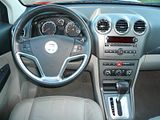


The Vue is deemed to be an SUV, but I know from experience that this is a US term and this can mean quite a large car. I was quite surprised to discover that in fact it measures just 180″, which does make it relatively compact in length, and it is noticeably narrower than many of its domestic competitors. It certainly does not feel that way from the inside, or when manoeuvering it around. In the cabin that means that there is ample space for rear seat passengers, who get decent legroom and the advantages of the extra headroom conferred by the extra height of the SUV design. There are deep door pockets, a generous cubby between the seats, console cup holders, a small stowage area in front of the gear lever and a reasonable glove box. The front seats have a net on the rear face which could be used to secure maps and papers.
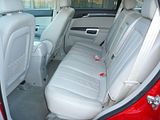
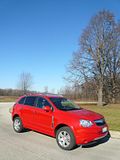
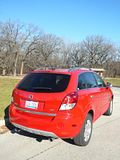
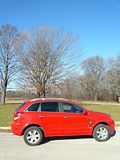
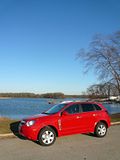
The boot is surprisingly shallow, but it is quite deep from back to front. As with most US rental cars, there is no cover provided to hide the contents form view. There is a removable floor, which pivots up when you release two small catches on either side of the floor panel, under which you find the spare wheel and space for a few small odds and ends. This makes the floor flush with the tailgate opening, but it is quite a lift up, which you notice when you have a heavy suitcase to heave in to the cargo area. There are also some very deep oddments areas moulded to the side of the boot, between the rear wheel arches and the rear of the car. Various apertures on the boot sides look like they would accommodate sliding shelves of some sort. The rear seats, split asymmetrically, fold down, by dropping the backrest onto the rear seat cushion, extending the luggage space quite considerably.
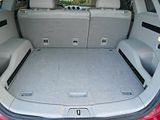
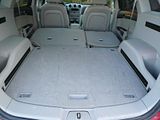
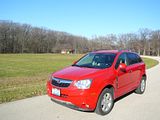
Handing the Vue back, I pondered my conclusion. Despite being a newer design than the Torrent, it did not strike me as an obviously “better” car. The ideal GM product in this class would probably take a combination of the better features from each. Maybe that car is the new Equinox, and I hope to get the chance to test that before too long. I did also reflect on my test of Ford’s rival, sampled in Mercury Mariner format earlier in the year and from what I recall of that car, it was not a clear class winner, either. So what is? Honest answer is that I am not sure. If you can live with the styling and the thirst, the latest Murano may well be the best to drive, though it is more costly to buy and has less room in it. Nissan offer a slightly smaller SUV, called the Rogue, and that has been quite well received. It is certainly less gawky than the Honda CRV and Acura RDX. Korea’s offerings are worthy enough, but ultimately not that exciting, either. My suspicion is that the Mazda CX-7 may be the car to beat in the small SUV market, States side. I need to find one and test it to see if I am right.
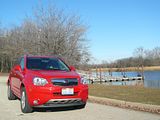
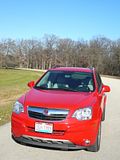
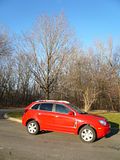
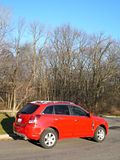
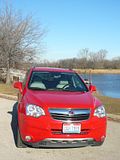
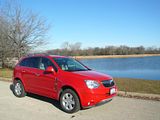
2009-12-07 13:45:03














































